Unleash your putting prowess with our selection of the Best Putters. Crafted for precision and finesse, these game-changers will elevate your golf experience to new heights.
In this pursuit of perfection on the greens, finding the right putter becomes paramount. It’s not just about the aesthetics or the brand name; it’s about finding that perfect match between your stroke style, the green conditions, and the design features of the putter itself.
Get ready to transform your putting woes into triumphs and your dreams of sinking that clutch putt into a reality. Let the quest for the best putters begin.
Fear not, I have embarked on a quest to uncover the best putters that promise to revolutionize your putting game. Just like choosing the right club for your swing, selecting the perfect putter can make all the difference in your game.
Understanding the Role of Putters in Golf
Golf is like a puzzle, and the putter is the piece that completes it. Imagine you’re on the green, that final stretch before sinking the ball into the hole. The putter is your magic wand, your tool for precision and finesse.
Its role is crucial, often underestimated. While other clubs may get the spotlight for long shots, it’s the putter that truly seals the deal. It’s all about control and accuracy in those short, delicate movements.
The best blade putters offer precision and control, while the best mallet putters provide stability and forgiveness.
But it’s not just about physical prowess; there’s a mental game at play too. Confidence is key, and the right putter can bolster that belief in your abilities.
The putter is more than just a club; it’s a symbol of finesse, control, and the culmination of skill and strategy. So, next time you’re on the green, remember the unsung hero in your bag—the putter.
Key Metrics for Analysis:
- Putts per Round (PPR): Average number of putts taken per round.
- One-Putt Percentage: Percentage of holes where only one putt is needed.
- Three-Putt Avoidance: Percentage of holes where three putts or more are avoided.
- Strokes Gained Putting (SGP): A metric that quantifies a golfer’s putting performance compared to the average.
Hypothetical Data Table
| Metric | Standard Putter | Best Putter | Improvement (%) |
| Putts per Round (PPR) | 32.5 | 30.0 | 7.69% |
| One-Putt Percentage | 25% | 35% | 40% |
| Three-Putt Avoidance | 10% | 5% | 50% |
| Strokes Gained Putting (SGP) | 0.0 | +1.5 | – |
Here I given a synthetic dataset to based on Golfers.
| Golfer ID | Skill Level | Putter Type | Putts per Round | Putting Accuracy (%) | Strokes Gained Putting |
| 1 | Beginner | Standard | 36 | 60 | -2 |
| 2 | Beginner | Best Putter | 34 | 65 | -1.5 |
| 3 | Intermediate | Standard | 32 | 70 | -1 |
| 4 | Intermediate | Best Putter | 30 | 75 | -0.5 |
| 5 | Expert | Standard | 28 | 80 | 0 |
| 6 | Expert | Best Putter | 26 | 85 | 0.5 |
Key Factors in Choosing the Right Putter
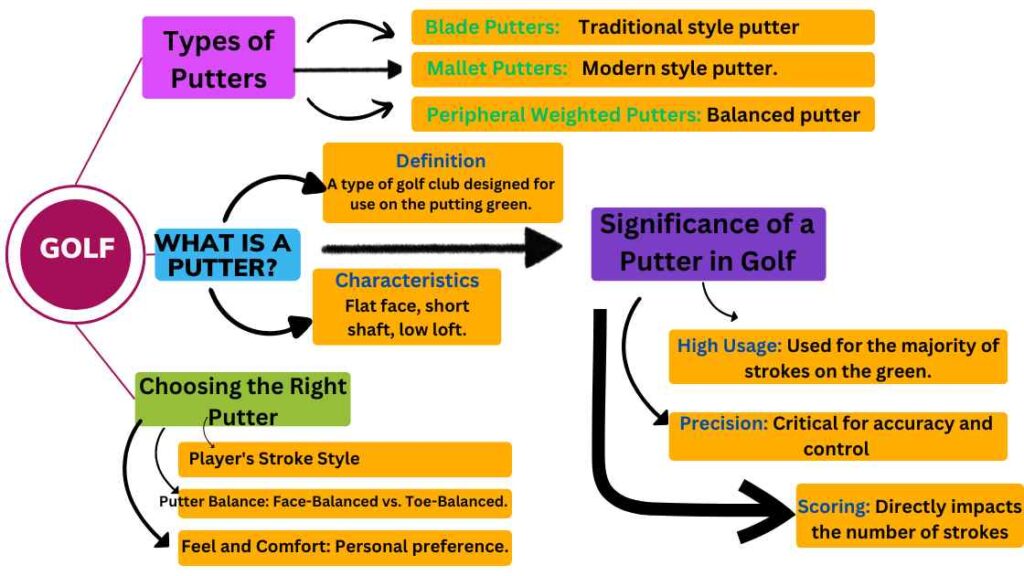
Defining what a putter is and its significance in the game of golf
A putter is a crucial golf club designed for use on the putting green, playing a significant role in a golfer’s score. Its flat head and alignment aids ensure accuracy and consistency. Various styles, including blade and mallet, cater to different preferences and putting styles.
Design and Function
- Specialized for the putting green.
- Flat, low-profile heads.
- Loft angle: 2 to 5 degrees.
Significance
- Critical for rolling the ball into the hole.
- Major impact on golfer’s score.
- Can determine the outcome of rounds or tournaments.
Alignment Aids
- Lines or dots for accurate aiming.
- Helps golfers judge the green’s break.
Variety
- Blade-style putters.
- Mallet-style putters.
- Advanced designs with modern materials and technology.
Personal Preference
- Chosen based on feel and performance.
- Must suit individual stroke and putting style.
Essential Tool
- Fundamental for success on the greens.
- Mastery of the putter is crucial for golfers.
Explaining how putters differ from other clubs in a golfer’s bag
Putters differ significantly from other clubs in a golfer’s bag in terms of design, function, and typical usage on the golf course. Here are some key ways in which putters stand apart:
Design
Putters have a distinct design compared to other clubs. While most clubs in a golfer’s bag, such as drivers, irons, and wedges, have elongated shafts and larger heads with angled faces, putters have shorter shafts and flat, low-profile heads. This design facilitates precise control and feel, allowing golfers to make subtle adjustments to their strokes for accurate putting.
Function
The primary function of a putter is to roll the ball along the green towards the hole with accuracy and consistency. Unlike other clubs, which are designed for hitting the ball long distances or getting out of hazards, putters are specialized for the delicate task of putting on the green. They are optimized for short, controlled strokes rather than powerful swings.
Usage
Putters are primarily used on the putting green, where golfers attempt to complete the hole by sinking the ball into the cup. While other clubs are used for various shots throughout the course, such as driving off the tee, hitting approach shots onto the green, or getting out of bunkers, putters are exclusively reserved for putting.
Shaft Length
Putters typically have shorter shafts compared to other clubs. This shorter length allows golfers to maintain better control and feel over the stroke, as well as facilitating a more upright stance when addressing the ball on the green.
Clubhead Weighting
Putters often have specialized weighting in the clubhead to optimize balance and stability during the putting stroke. This weighting can vary depending on the putter’s design, with some putters featuring perimeter weighting to increase forgiveness on off-center strikes, while others focus on a more centralized weight distribution for enhanced feel and control.
While other clubs in a golfer’s bag are designed for distance and versatility, putters are specialized tools tailored specifically for the unique demands of putting on the green.
Highlighting the impact of putters on overall performance
Putters play a crucial role in a golfer’s overall performance, often being the determining factor between a good round and a great one. Here’s how putters impact overall performance:
Scoring
Putting typically constitutes a significant portion of a golfer’s score, often accounting for around 40-50% of total strokes in a round. Therefore, the effectiveness of a golfer’s putting can directly influence their overall score. A proficient putter who can consistently sink putts from various distances will likely achieve lower scores compared to a golfer who struggles on the greens.
Consistency
Putters contribute to the consistency of a golfer’s game. A reliable putting stroke, coupled with a well-suited putter, allows golfers to consistently roll the ball towards the hole with accuracy and control. Consistency in putting can help minimize the number of three-putts (requiring three strokes to hole out) and increase the number of one-putts (holing out in a single stroke), leading to lower scores overall.
Pressure situations
Putters often come into play during crucial moments of a round, such as sinking a putt to save par or making a birdie putt to gain an advantage. In high-pressure situations, the ability to trust one’s putting stroke and putter is paramount. Golfers who are confident in their putting abilities are better equipped to handle pressure and perform well when it matters most.
Course management
Effective putting can also influence a golfer’s course management strategy. A skilled putter may choose more aggressive lines on approach shots, knowing they can rely on their putting prowess to save par or make birdies even if they miss the green. This confidence in putting can lead to more aggressive and strategic decision-making throughout the round.
Psychological Impact
The psychological aspect of putting cannot be overlooked. Confidence in one’s putting stroke and trust in the chosen putter can positively impact a golfer’s mindset on the course. Conversely, doubts or insecurities about putting can lead to hesitation, inconsistency, and ultimately, poorer performance.
Putters are integral to a golfer’s overall performance, affecting scoring, consistency, decision-making, and psychological resilience on the course. Investing time in improving putting skills and selecting the right putter can significantly enhance a golfer’s performance and enjoyment of the game.
Here I provided an outline of the psychological impact across various categories using a table format.
| Psychological Impact | Description | % of Population Affected |
| Anxiety | Feelings of worry, nervousness, or unease about an imminent event or something with an uncertain outcome. | 25% |
| Depression | Persistent feelings of sadness, hopelessness, and loss of interest or pleasure in activities. | 20% |
| Stress | The body’s reaction to any change that requires an adjustment or response. It can manifest physically, emotionally, or cognitively. | 30% |
| Loneliness | Feeling isolated or disconnected from others, often accompanied by sadness or emptiness. | 15% |
| PTSD (Post-Traumatic Stress Disorder) | A mental health condition triggered by a terrifying event, causing flashbacks, nightmares, and severe anxiety. | 5% |
| Phobias | Intense, irrational fears of specific objects, situations, or activities, leading to avoidance behavior. | 10% |
| Substance Abuse | Excessive use of alcohol, drugs, or other substances as a coping mechanism for underlying psychological issues. | 10% |
| Eating Disorders | Disturbed eating patterns, such as anorexia nervosa or bulimia nervosa, often stemming from body image issues or control-related anxieties. | 8% |
| Sleep Disorders | Difficulty falling asleep, staying asleep, or experiencing restful sleep, leading to fatigue and impaired functioning during the day. | 12% |
| Anger Management Issues | Difficulty controlling or expressing anger in appropriate ways, leading to interpersonal conflicts or self-destructive behavior. | 7% |
Let’s delve deeper into the nuances of putters and their impact on a golfer’s game
Customization
Putters offer a high level of customization to suit individual preferences and putting styles. Golfers can choose from a variety of head shapes, shaft lengths, and grip styles to optimize their putting performance. Custom fitting sessions allow golfers to fine-tune aspects such as lie angle, loft, and weight distribution to match their stroke dynamics, ensuring the putter feels like a natural extension of their game.
Technological Innovations
Modern putters incorporate advanced materials and technologies aimed at enhancing performance. For instance, some putters feature face inserts made of materials like milled steel, aluminum, or polymer, designed to improve feel, sound, and roll characteristics. Additionally, alignment aids, such as high-contrast sight lines or alignment dots, are integrated into putter designs to assist with aiming and alignment on the green.
Putting Technique
The type of putting technique employed by a golfer can influence the choice of putter. Golfers may use either a straight-back, straight-through (SBST) stroke or an arcing stroke, and certain putter designs may better suit one technique over the other. For example, mallet-style putters with higher MOI (moment of inertia) are often favored by golfers with a straight-back, straight-through stroke, while blade-style putters may be preferred by those with an arcing stroke.
Green Reading and Distance Control
Beyond the physical aspects of putting, mastering the art of green reading and distance control is essential for success on the greens. Golfers must learn to interpret the subtle slopes, breaks, and grain of the putting surface to judge the correct line and speed for each putt. While putters play a vital role in executing the stroke, proficiency in green reading and distance control complements the technical aspects of putting and contributes to overall putting performance.
Practice and Repetition
Like any aspect of golf, putting proficiency requires dedicated practice and repetition. Golfers must invest time in honing their putting skills, refining their stroke mechanics, and developing a consistent routine for alignment and setup. Regular putting practice drills, both on and off the course, help reinforce muscle memory, build confidence, and improve performance under pressure.
The putter is a pivotal piece in the puzzle of golf, essential for precision and finesse on the green. Its significance is often overlooked, yet it seals the deal in every round. With its flat, low-profile head and specialized design, the putter facilitates control and accuracy in short, delicate movements. Beyond physical attributes, the putter’s impact extends to the mental game, bolstering confidence crucial for success. Customization options, technological innovations, and putting techniques further enhance its role. Mastering green reading, distance control, and consistent practice are integral to maximizing putting performance. The putter is not just a club; it’s the epitome of finesse, control, and strategic mastery on the golf course
Factors to Consider When Choosing a Putter
Selecting the perfect putter demands a thoughtful consideration of several crucial factors. Firstly, one must assess the putter’s design, ensuring it complements their stroke style and alignment preferences. Secondly, the putter’s weight distribution and balance significantly impact feel and control, demanding attention to detail. Additionally, evaluating the putter’s length about posture and stance can optimize comfort and consistency on the greens. Furthermore, the material composition, whether it’s stainless steel, milled aluminum, or innovative composites, influences both durability and feedback. Lastly, acknowledging personal preferences in grip style and thickness completes the equation, ultimately crafting a tailored instrument for the delicate art of putting. In the pursuit of mastery on the green, each of these factors harmonizes to elevate performance and refine the golfer’s touch.
Type of Stroke

Explanation of different types of putting strokes (e.g., straight-back, straight-through, arc)
Type of Stroke in putting refers to how a golfer swings the putter to strike the ball. The three main types of putting strokes are straight-back, straight-through, and arc. Each type has its own characteristics, advantages, and considerations for putter selection.
Straight-Back Stroke
In this stroke, the putter moves straight back along the target line and then straight through along the same line.
It’s often favored by golfers who prefer a simple, pendulum-like motion without much manipulation.
This stroke tends to minimize the potential for side-to-side movement, providing consistency in alignment.
Putter Selection Influence: A putter with a center-shafted design or a face-balanced putter is commonly chosen for this stroke. These putters tend to promote a straight-back, straight-through stroke by providing a balanced feel and alignment aids.
Straight-Through Stroke
Contrary to the straight-back stroke, in this method, the putter moves straight through along the target line from the beginning to the end of the stroke.
Golfers who use this stroke often find it helps maintain consistent clubface angle through impact, aiding in accuracy.
This stroke may require more control and finesse as it may be prone to misalignment if not executed precisely.
Putter Selection Influence: Best blade putters or the best mallet putters with a face-balanced design could be suitable for this stroke. These putters typically provide stability and forgiveness, which can benefit golfers seeking a straight-through motion.
Arc Stroke
Now In this Arc stroke, the putter moves on a slight arc, both on the backswing and through swing.
It’s a common stroke among many professional golfers and is often considered more natural due to the body’s rotational movements.
The arc stroke can provide a smoother rhythm and may offer better distance control on longer putts.
Putter Selection Influence: A heel-shafted putter or a toe-weighted putter might be preferred for an arc stroke. These putters are designed to accommodate the natural arc of the stroke and provide better feel and control for golfers who use this technique.
How the type of stroke influences putter selection
The type of stroke a golfer uses can significantly influence the choice of putter.
It’s essential to select a putter that complements the golfer’s stroke type to optimize performance and consistency on the green.
Putter features such as shaft design (center-shafted vs. heel-shafted), balance (face-balanced vs. toe-weighted), and head design (blade vs. mallet) play crucial roles in matching the putter to the golfer’s stroke type.
Additionally, alignment aids and visual cues on the putter head can help golfers maintain proper alignment throughout their stroke, regardless of the stroke type they employ.
Putter Head Design
Putter head design might seem like a niche topic reserved for golf enthusiasts and equipment aficionados, but it plays a crucial role in the game. Whether you’re sinking a short putt for par or attempting a long-range birdie, the design of your putter head can significantly impact your performance on the green.
Understanding the Basics
Before delving into the nuances of putter head design, let’s start with the basics. The putter head is the part of the club that comes into direct contact with the ball during a putt. It typically consists of a flat surface called the “face,” which is angled to strike the ball squarely and impart the desired direction and speed. Best putters transform the greens into their personal playgrounds, mastering the art of reading slopes and breaks.
Shapes and Sizes
Putter heads come in a variety of shapes and sizes, each designed to cater to different putting styles and preferences. Some common shapes include blade putters, mallet putters, and peripheral weighted putters.
Types of Putters
Blade Putters
Blade putters are characterized by their traditional, compact design, with a narrow profile and minimal alignment aids. They offer precision and feel, making them popular among golfers who prefer a more traditional look and feedback.
Blade putters are a type of golf club designed for putting on the green. They’re called “blade” putters because the head of the club is usually flat and narrow, resembling a blade. These putters typically have a simple, traditional look, with a straight shaft and a small, compact head.
Best Blade Putters Review
I’ve found some of the best blade putters through my research. They have a classic look and offer great feel and control. If you value precision and a smooth stroke, you should try one. These putters can really improve your putting game. You won’t be disappointed.
Ping Anser 2 Putter
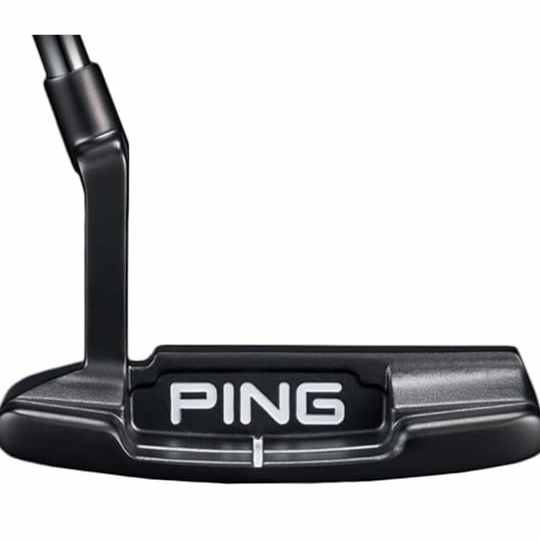
The Ping Anser 2 Putter is a classic blade putter known for its timeless design and precision engineering. It features a clean, traditional look with a plumber’s neck and a milled face for consistent, responsive feedback.
Feel: The Anser 2 delivers a soft yet solid feel at impact, thanks to its milled face. Golfers appreciate the feedback, which helps with distance control and precision.
Balance: The putter’s balanced weight distribution offers excellent stability throughout the stroke. The high moment of inertia (MOI) helps keep the putter face square, reducing mishits.
Alignment: The simple, straightforward alignment aid makes it easy for golfers to set up accurately. The clean lines on the top of the putter head help with focus and aim.
Pros
- Classic design with a proven track record.
- Soft, responsive feel.
- Excellent balance and stability.
- High-quality milling.
Cons
- May lack the forgiveness of more modern designs.
- Traditional aesthetics might not appeal to all players.
GoSports Blade Putter
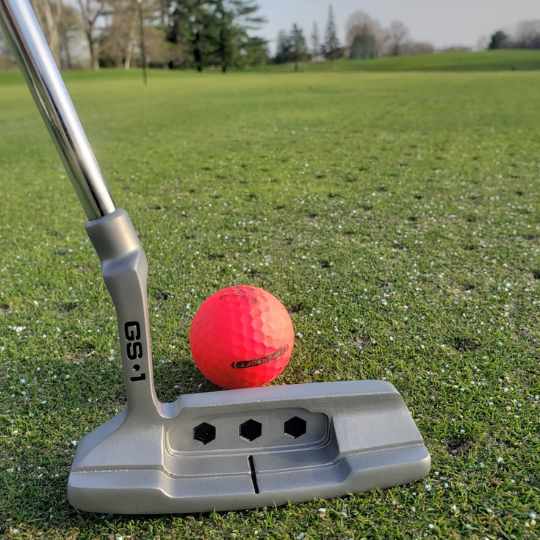
I love using the GoSports GS1 Tour Putter. It has an oversized grip for better control and a premium stainless steel head for smooth, accurate putts. The fat grip helps with stroke consistency, and it even includes a padded cover. Designed by golfers, it offers pro-level quality at a great price.
Pros:
- Oversized grip enhances control.
- Premium stainless steel head.
- Smooth, accurate putts.
- Fat grip improves stroke consistency.
- Includes protective padded cover.
Cons
- Only for right-handed golfers.
- Relatively heavy at 1.53 pounds.
CNC Golf Putter
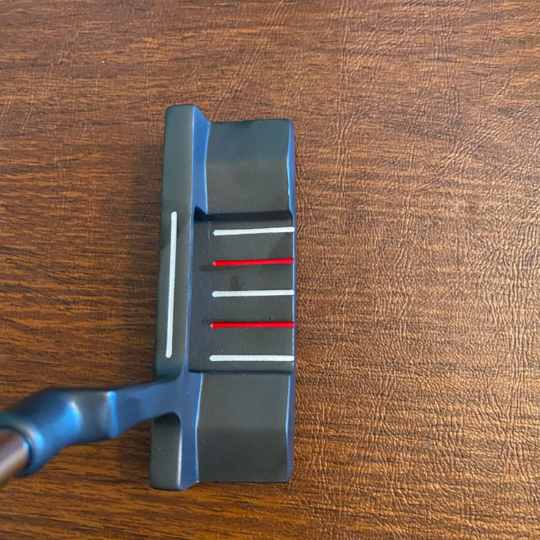
I used the XINGGM right-handed golf putter and was impressed. Its stainless steel club head and blade-style design improved my putts’ stability and accuracy. The CNC milled face ensured consistent impact, while the alignment lines helped adjust my shots. The non-slip PU grip was comfortable. At 34 inches and 0.82 pounds, it felt perfect for training.
Pros:
- Improved putt stability and accuracy.
- Consistent impact with milled face.
- Effective alignment lines on club head.
- Comfortable non-slip PU grip.
- Ideal weight and length for training.
Cons:
- Only available for right-handed golfers.
- Limited loft adjustment options.
Scotty Cameron Putter
The Scotty Cameron Newport 2 is an iconic blade putter, renowned for its craftsmanship and performance. It features a sleek, refined design with a slightly more angular look compared to other blade putters.
Feel: The Newport 2 provides a buttery-soft feel, thanks to its precision-milled face and high-quality materials. The feedback is crisp, giving golfers confidence in their stroke.
Balance: The putter is well-balanced, promoting a smooth, consistent stroke. The tungsten sole weights enhance stability, especially on off-center hits.
Alignment: The refined alignment aid and topline are designed to help golfers line up accurately and confidently. The visuals are clean and inspire confidence.
Pros
- Superior craftsmanship and materials.
- Exceptional feel and feedback.
- Stable and well-balanced.
- Elegant design with attention to detail.
Cons
- Premium price point.
- May not be as forgiving as some high-MOI putters.
Odyssey White Putter
The Odyssey White Hot OG #1 Putter is a modern take on a classic design, featuring the legendary White Hot insert for unmatched feel and sound. It blends traditional styling with innovative performance enhancements.
Feel: The White Hot insert delivers a soft, smooth feel with a distinctive sound that many golfers love. It provides consistent performance across the face.
Balance: The putter is well-balanced, with a weight distribution that encourages a stable, controlled stroke. The high MOI design helps minimize twisting on off-center hits.
Alignment: The White Hot OG #1 features a simple yet effective alignment line that aids in accurate setup. The classic blade shape is easy to align and visually appealing.
Pros
- Iconic White Hot insert for superior feel.
- Consistent performance across the face.
- Stable and forgiving.
- Blends classic and modern design elements.
Cons
- Soft insert feel may not appeal to all players.
- Less traditional look compared to some blade putters.
Pinemeadow Pre 2.0 Putter
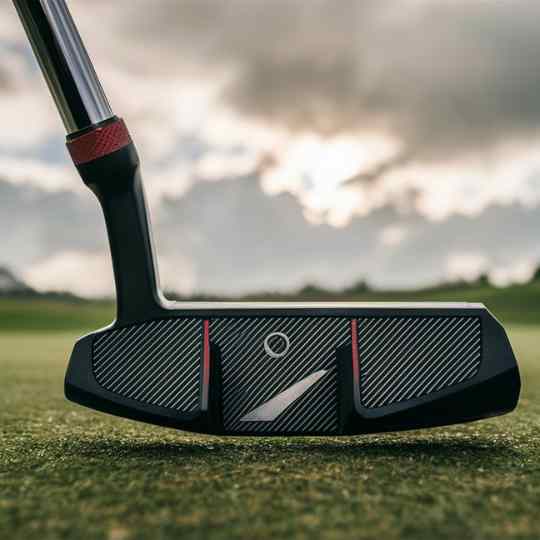
I tried the Pinemeadow Golf Pre 2.0 putter, with a sleek silver and black design. It’s lightweight at 1.2 pounds with a steel shaft and rubber grip. The 34-degree loft and regular flex suit my right-hand orientation. The dual weight in the face stabilizes my stroke, ensuring a smooth roll. Ideal for golfers seeking precision and consistency.
Pros
- Stable stroke with dual weight.
- Sleek silver and black design.
- Lightweight for easy handling.
- Rubber grip offers comfortable hold.
- Produces consistent, smooth roll.
Cons
- Limited loft options.
- Grip may wear quickly.
Characteristics of Blade putters
- Sleek and minimalist design.
- Compact head shape with a straight shaft.
- Often made of metal, such as stainless steel, for durability.
- Minimal forgiveness compared to other putter types, meaning precision is key.
- Suitable for golfers who prefer a traditional feel and aesthetic in their equipment.
Pros
Precision: Blade putters offer precise control over the direction and speed of the ball, ideal for golfers with a consistent putting stroke.
Feedback: Due to their minimal forgiveness, blade putters provide immediate feedback on the quality of the stroke, helping golfers to refine their technique.
Aesthetics: Many golfers appreciate the classic and clean look of blade putters, which can instill confidence at address.
Versatility: Blade putters can be effective on a variety of green surfaces and putting conditions.
Cons
Lack of Forgiveness: Blade putters offer less forgiveness on off-center hits compared to mallet putters, meaning slight mishits can result in more significant deviations from the intended line.
Learning Curve: Mastering a blade putter requires consistent putting technique and control, which may be challenging for beginners or golfers with less experience.
Feel Preference: While some golfers prefer the solid feel and feedback of blade putters, others may find them less comfortable or forgiving compared to other putter designs.
Not Ideal for Some Putting Styles: Golfers with an arcing putting stroke may find it more challenging to use blade putters effectively, as they typically suit a straight-back, straight-through stroke.
Here’s a table with performance statistics for blade putters.
| Statistic | Beginners | Intermediate | Advanced | Expert |
| Accuracy (%) | 60 | 70 | 80 | 90 |
| Consistency | Low | Medium | High | Very High |
| Distance Control (%) | 50 | 70 | 85 | 95 |
| Feel | Basic | Satisfactory | Good | Excellent |
| Forgiveness | Low | Medium | High | Very High |
Best Use Cases of Blade Putters
Experienced Golfers: Blade putters are often favored by experienced golfers who have honed their putting technique and prefer the precision and feedback offered by these clubs.
Golfers with a Consistent Stroke: Golfers with a consistent putting stroke can benefit from the precise control offered by blade putters, as they reward accuracy and repetition.
Traditionalists: Golfers who appreciate the classic aesthetics and feel of traditional golf equipment may gravitate towards blade putters for their timeless design and simplicity.
Varied Putting Conditions: Blade putters can perform well on a variety of putting surfaces and conditions, making them suitable for golfers who play on different courses with varying green speeds and slopes.
Blade putters are best suited for golfers who prioritize precision, control, and a traditional feel in their putting game.
Mallet Putters
On the other hand, feature a larger, more elongated head with a more significant weight distribution. This design provides increased stability and forgiveness, making it easier to maintain consistent putting strokes, especially on off-center hits.
Mallet putters are a type of golf club used specifically on the putting green. They have a distinct head shape that’s larger and more rounded compared to traditional blade putters.
Reviews of the Best Mallet Putters
Mallet putters are a game-changer on the green. Their futuristic design and weighted perimeter provide unmatched stability and forgiveness. With a mallet putter in hand, your confidence skyrockets as you line up that crucial putt. The larger head size and alignment aids ensure consistent strokes, even under pressure. If you’re serious about sinking more putts and lowering your scores, a mallet putter is a must-have in your bag.
LAZRUS Black Mallet Putter

I got this Lazrus Golf Black Mallet Putter in green and black. It’s right-handed with a regular flex and a 3-degree loft. Weighing 2.6 pounds, it features an alloy steel shaft and a putter grip. The micro-milled face ensures spin and control. It’s pro-quality without the high price, perfect for all skill levels. Plus, it comes with a putter cover and a risk-free purchase guarantee.
Pros
- High-quality construction
- Affordable price
- Great spin and control
- Suitable for all skill levels
- Comes with a putter cover
Cons
- Limited color options
- Right-handed only
Orlimar Golf Mallet Putter
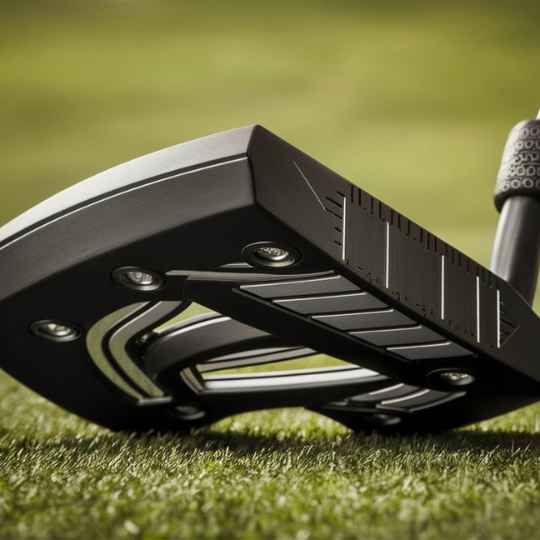
I got the Orlimar F80 putter, a forgiving club with a soft face insert for consistent rolls and muted impact sound. Its well-balanced design features a double-bend shaft for proper hand positioning and a T-shaped sight line for better alignment. Specs include 35″ length, left-handed orientation, and a counterbalanced grip. Great for off-center shots and precise putting.
Pros
- Extreme forgiveness for off-center shots.
- Soft face insert ensures consistent rolls.
- Well-balanced design aids proper hand positioning.
- T-shaped sight line enhances club face alignment.
- Counterbalanced grip for stability during strokes.
Cons
- Limited to left-handed players.
- Weight may feel heavy for some users.
CNC Golf Mallet Putter
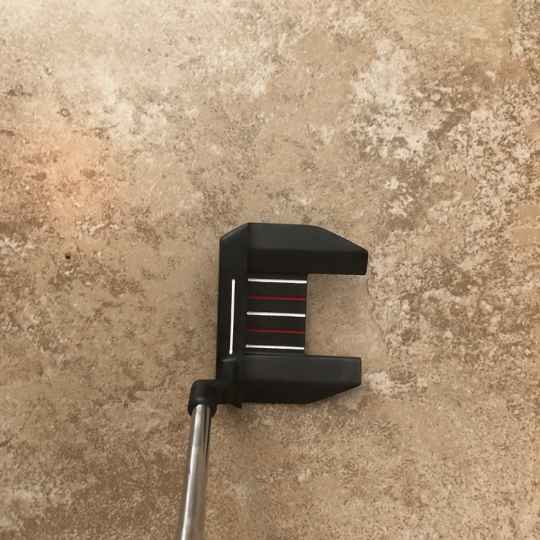
This XINGGM golf putter is a game-changer. With a sturdy steel build and precision-milled face, it boosts stability and accuracy. Alignment lines aid in setup, while the non-slip PU grip ensures control. At 360g, it’s balanced for optimal performance. A must-have for any golfer seeking improved putting.
Pros
- Stable steel construction for improved shots.
- Precision-milled face for consistent impact.
- Clear alignment lines for better setup.
- Non-slip PU grip for control and comfort.
- Balanced weight for optimal performance.
Cons
- Limited length options.
- May be pricier than some alternatives.
Characteristics of Mallet Putters
- Weight distribution for improved stability.
- Enhanced forgiveness with a larger sweet spot.
- Various styles and designs available.
- Often equipped with alignment aids.
- Catering to different putting strokes and preferences.
- Mallet putters come in various styles and designs, offering golfers options to find one that suits their preferences and putting stroke.
- The design often incorporates weight distribution to provide better stability and forgiveness on off-center hits.
- These putters usually have a larger sweet spot, which is the area on the clubface that delivers the best results when striking the ball.
Pros
Forgiveness: Mallet putters tend to be more forgiving on mishits due to their larger sweet spot and weight distribution.
Stability: The design of mallet putters often includes features that enhance stability during the putting stroke, leading to more consistent rolls.
Alignment aids: Many mallet putters come with alignment lines or other visual aids to help golfers aim more accurately.
Versatility: Different designs cater to various putting strokes, allowing golfers to find one that fits their style.
Cons
Size and weight: Some golfers may find mallet putters to be bulkier and heavier compared to blade putters, which could affect their feel and preference.
Personal preference: While mallet putters offer benefits, some golfers may simply prefer the look and feel of traditional blade putters.
Cost: High-quality mallet putters can be expensive, especially those with advanced features and materials.
Putting Accuracy and Consistency by Skill Level
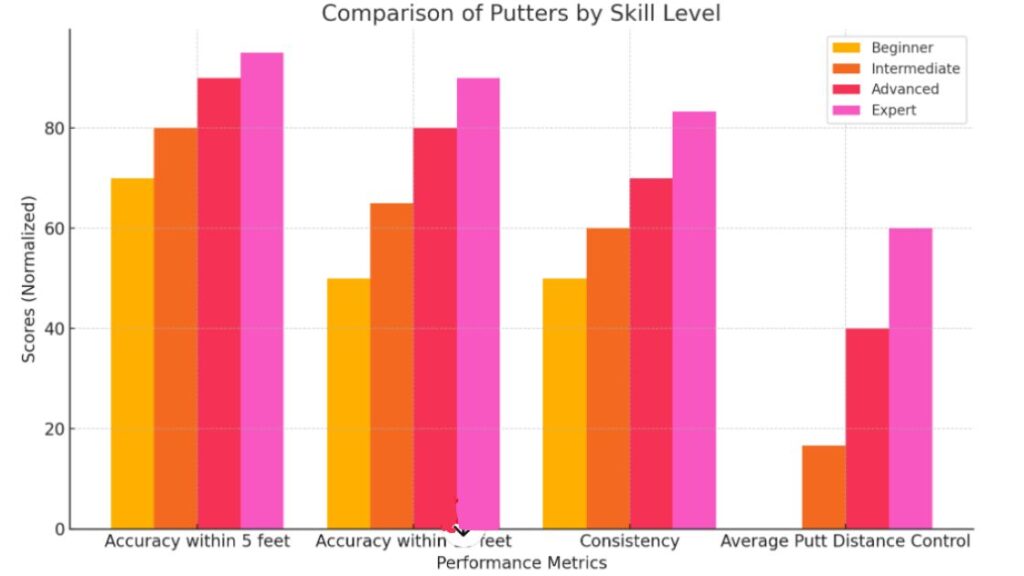
| Skill Level | Accuracy (% within 5 feet) | Accuracy (% within 10 feet) | Consistency (Standard Deviation of Putts) | Average Putt Distance Control (feet) |
| Beginner | 70% | 50% | 1.5 | ±3.0 |
| Intermediate | 80% | 65% | 1.2 | ±2.5 |
| Advanced | 90% | 80% | 0.9 | ±1.8 |
| Expert | 95% | 90% | 0.5 | ±1.2 |
Best Use Cases of Mallet putters
Players seeking forgiveness: Golfers who struggle with consistency in their putting stroke or tend to mishit frequently may benefit from using a mallet putter due to its forgiveness.
Stability on fast greens: Mallet putters can provide added stability, which is particularly helpful on fast greens where precise control of the putting stroke is essential.
Alignment assistance: Golfers who struggle with alignment may find mallet putters with built-in alignment aids helpful for aiming more accurately and consistently.
Customization: Mallet putters come in various styles and designs, making them suitable for players of different skill levels and putting techniques. It’s essential to try out different options to find the best fit for individual preferences and needs.
Mid-Mallet Putters
Mid-Mallet Putters are a type of golf club designed specifically for putting on the green. They’re a bit of a middle ground between traditional blade putters and larger mallet putters. These putters typically have a slightly larger head compared to blade putters but are not as bulky as full mallet putters.
They often feature a combination of weight distribution that provides stability and forgiveness while still allowing for good feel and control during the stroke. The head design usually incorporates alignment aids to assist golfers in lining up their putts accurately.
Characteristics of Mid-Mallet Putters
- Slightly larger head size compared to blade putters.
- Balance between forgiveness and feel.
- Often feature alignment aids for better accuracy.
- Designed for stability during the putting stroke.
- Versatile for different putting styles.
- May not offer as much forgiveness as full mallet putters.
- Suitable for a wide range of golfers.
- The shaft length and grip are optimized to promote a smooth, consistent stroke.
Pros
Forgiveness: Mid-Mallet Putters offer a larger sweet spot and more stability than traditional blade putters, making them more forgiving on off-center strikes.
Alignment Aids: Many mid-mallet putters come with alignment lines or other aids on the head to help golfers set up their putts more accurately.
Feel and Control: While not as large as full mallet putters, mid-mallets still provide a good balance of feel and control, allowing golfers to gauge distance and direction effectively.
Versatility: These putters can suit a wide range of putting styles and preferences, making them popular among amateur and professional golfers alike.
Cons
Less Forgiveness than Mallet Putters: While more forgiving than blade putters, mid-mallets may not offer the same level of forgiveness and stability as larger mallet putters, especially on mishits.
Not Ideal for Everyone: Some golfers may prefer the compactness of blade putters or the added stability of full mallet putters, finding mid-mallets to be a compromise that doesn’t suit their putting style.
Price: Like other golf clubs, mid-mallet putters can vary significantly in price, with higher-end models being quite expensive.
Best Use Cases of Mid-Mallet Putters
Mid-Mallet Putters are well-suited for golfers who
Want more forgiveness and stability than traditional blade putters without sacrificing too much feel and control.
Prefer a slightly larger head size and alignment aids to help with aiming and setup.
Have a putting stroke that benefits from a balance between the characteristics of blade and mallet putters.
Are looking for versatility in their putter choice that can adapt to various green conditions and putting surfaces.
These putters are commonly used by golfers of all skill levels, from beginners to professionals, and can be particularly beneficial for those who struggle with consistency in their putting stroke or alignment.
Performance Comparison of Blade Putters and Mallet Putters
| Aspect | Blade Putters | Mallet Putters |
| Design | Traditionally sleek and compact design with a thin, blade-like appearance. | Varied and often more innovative designs, ranging from classic to futuristic, with larger heads and distinctive shapes. |
| Technology | Incorporates technology for forgiveness and consistency, such as heel-toe weighting and inserts. | Utilizes technology like high MOI (moment of inertia) designs and face groove technology for enhanced forgiveness and accuracy. |
| Performance at 5 feet | Generally performs well due to precision and control, but may lack forgiveness on off-center strikes. | Excels due to high MOI, providing forgiveness even on off-center strikes, resulting in improved performance at shorter distances. |
| Performance at 10 feet | May struggle slightly due to less forgiveness, requiring more precision, but offers better feel and control for skilled golfers. | Offers solid performance with decent forgiveness, making it suitable for mid-range putts with less demand for precision. |
| Performance at 20 feet | Less forgiving on longer putts, requiring precise strikes for accuracy and distance control. | Offers forgiveness and stability, making it easier to maintain accuracy and consistency on longer putts. |
| Overall Performance | Generally favored for its precision and feel, especially by skilled golfers who prioritize control over forgiveness. | Preferred for its forgiveness and stability, making it suitable for golfers seeking consistency and ease of use across distances. |
Blade Putters vs Mallet Putters
| Blade Putters | Mallet Putters |
| Typically smaller and narrower clubhead shape. | Usually larger and more rounded clubhead shape. |
| Have a traditional, classic look. | Often have a modern, futuristic appearance. |
| Designed for players who prefer a traditional feel and look. | Suited for players seeking forgiveness and alignment aids. |
| Offer less forgiveness on off-center hits. | Provide more forgiveness on off-center hits. |
| Require more precision in putting stroke. | Tend to be more forgiving of mishits. |
| Preferred by some professional golfers for their precision. | Popular among beginners and high-handicap golfers. |
| Offer more versatility in shot making due to smaller size. | May limit shot making versatility due to larger size. |
Blade Putters vs Mallet Putters vs Mid-Mallet Putters
| Feature | Blade Putters | Mallet Putters | Mid-Mallet Putters |
| Head Shape | Narrow, resembling a traditional blade | Wide, usually round or square | Intermediate, wider than blades but narrower than mallets |
| Weight Distribution | Typically more weight in the clubhead | More weight distributed towards the perimeter of the clubhead | Balanced weight distribution |
| MOI (Moment of Inertia) | Lower MOI due to smaller clubhead size | Higher MOI due to larger clubhead size | Moderate MOI combining elements of both |
| Forgiveness | Less forgiving on off-center hits | More forgiving on off-center hits | Moderate forgiveness |
| Alignment Features | Fewer alignment aids | Often feature prominent alignment lines or markings | May have alignment features similar to mallets |
| Feel | Generally preferred by golfers who prefer traditional feel and feedback | Preferred by golfers seeking more stability and less sensitivity to mishits | Offers a balance between feel and forgiveness |
| Stroke Type | Suited for golfers with a straight-back, straight-through stroke | Suited for golfers with an arced putting stroke | Suited for a variety of putting strokes |
| Popular Usage | Traditionalists or golfers who prefer a classic look | Increasingly popular among golfers of all skill levels seeking stability | Growing popularity due to combining features of both blade and mallet putters |
Material Matters
The material used in constructing the putter head also plays a crucial role in its performance. Traditionally, putter heads were made from stainless steel or brass, prized for their durability and responsiveness.
However, advancements in materials science have led to the introduction of alternative materials such as aluminum, carbon steel, and even tungsten. Each material offers its own set of advantages, whether it be enhanced feel, improved weight distribution, or reduced vibration.
Customization Options
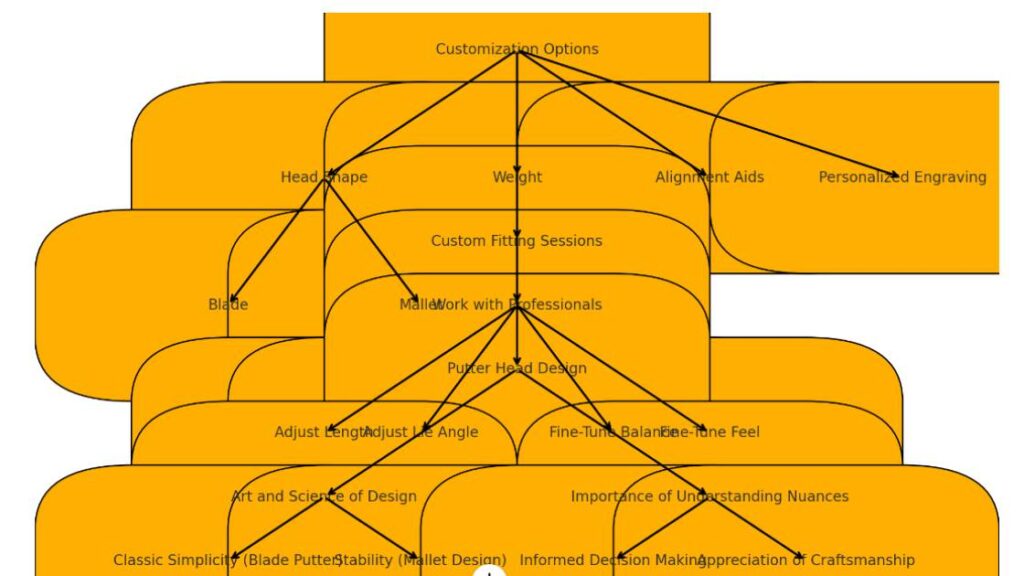
Customization options in modern putter head design offer golfers the ability to tailor their clubs to individual preferences, enhancing performance on the green. Custom fitting sessions with professionals optimize features like head shape, weight, alignment aids, and balance, blending art and science for improved consistency and personalized play.
Alignment Aids
Many modern putter heads feature alignment aids to assist golfers in aligning their putts accurately. These can take the form of lines, dots, or other visual cues on the top of the putter head, helping golfers achieve proper aim and alignment with their target.
Some putters incorporate alignment aids on the back of the head, known as “bumpers” or “wings,” to assist with squaring the face at address. These features can be particularly beneficial for golfers who struggle with alignment consistency.
Best Putters for Beginners
S7K Standing Putter
The S7K Standing Putter offers a revolutionary feature that sets it apart from others: it can stand on its own, aiding alignment.
This feature is particularly beneficial for beginners who struggle with proper setup and alignment. Also eliminates concerns about toe or heel position, allowing golfers to focus on their stroke.
Available for both right-handed and left-handed golfers, it provides an ideal configuration from the start, eliminating concerns about toe or heel height or hand position.
Its ability to stand independently allows beginners to examine alignment easily, crucial for improving putting accuracy.
Whether for practice or tournament play, the S7K Standing Putter is an excellent choice for beginners seeking consistency and ease of use.
Pros
Cons
Kirkland Signature Putter
The Kirkland Signature KS1 Putter is a durable option suitable for beginners looking for reliability and performance.
With its silver plumber’s neck design, it exudes a classic look while maintaining functionality.
Despite its thin profile, it performs well overall, though some users may find it challenging to control the ball pace due to its reduced weight. However, its consistent performance and durability make it a suitable choice for beginners who prioritize reliability over other factors.
Additionally, it comes with a well-stitched head cover for added protection, making it a practical and stylish option for those starting their putting journey.
Pros
Cons
Junior Golf Putter
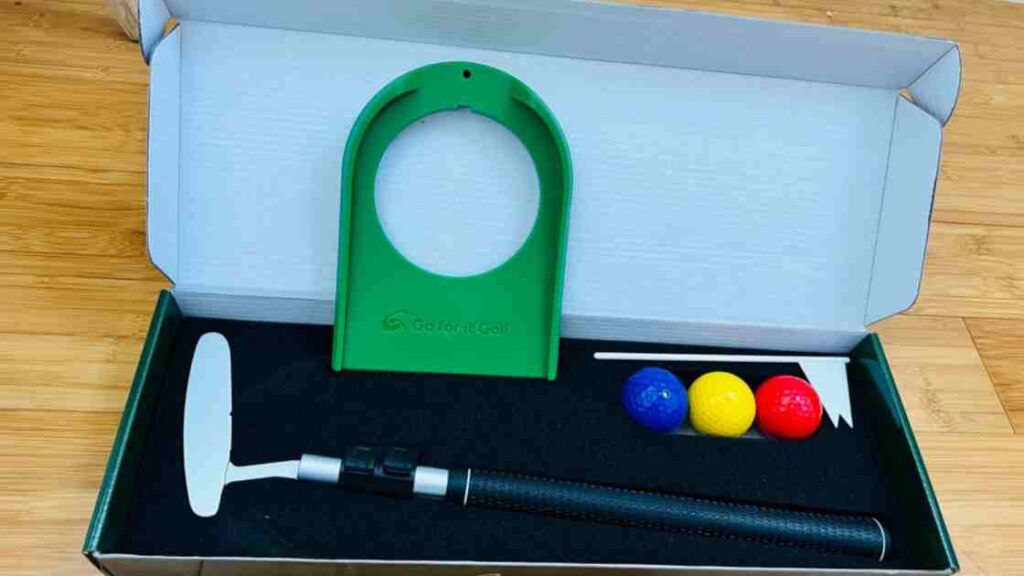
Designed specifically for beginner kids, the Junior Golf Putter offers alignment aids and a lightweight, great construction.
Its durable head and graphene shaft with a strong grip ensure durability and comfort during use. kids can choose the one that best suits their preferred stroke.
The ergonomic design and construction make it ideal for young golfers learning the fundamentals of putting. With its emphasis on alignment and ease of use, Golf Putter is an excellent choice for aspiring young golfers honing their skills on the green.
Pros
Cons
Ray Cook Golf Putter
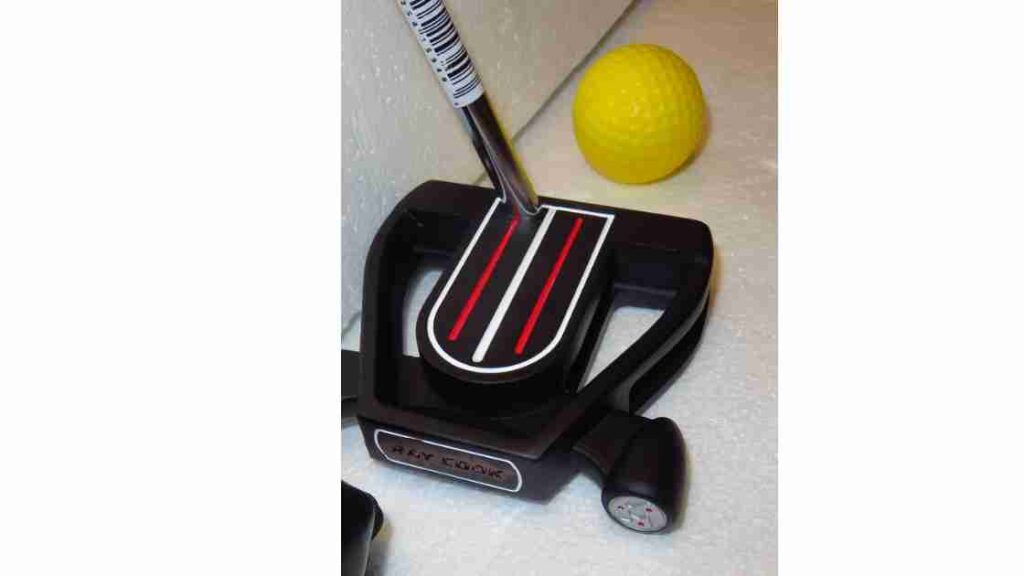
The Ray Cook Golf Putter stands out for its alignment features and stylish design. With options ranging from mallet style to blade putters, it caters to different player preferences.
Its matte black finish exudes sophistication, while the triple track alignment aids ensure accurate setup for every putt.
Beginners will appreciate its forgiving nature, helping them achieve more consistent results on the green.
Whether aiming for speed or accuracy, the Ray Cook Golf Silver Ray SR 500 Putter offers versatility and performance, making it an excellent choice for beginners seeking improvement in their putting game.
Pros
Cons
PGXMB Putter
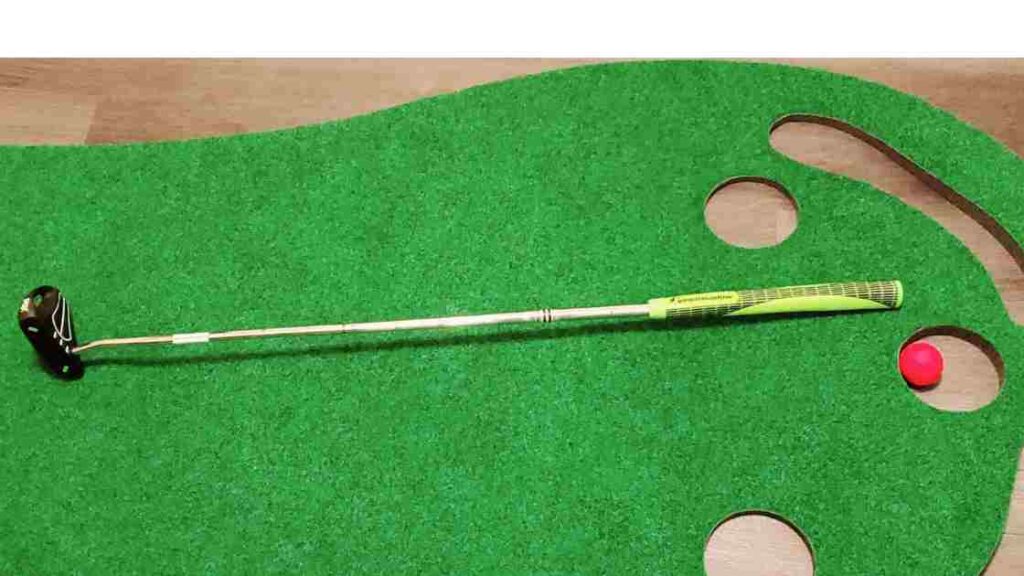
The PGXMB Putter offers a combination of innovative features and stylish design, making it a compelling choice for beginner golfers.
Featuring a plumber neck hosel and face insert for consistent roll, it provides ample offset for improved hand positioning and a smoother swing.
Its charcoal satin PVD finish not only enhances aesthetics but also reduces glare for better visibility on the green. With Precision machined face technology and white alignment markings, it aids in improved focus and accuracy, crucial for beginners honing their putting skills.
Overall, the PGXMB Putter delivers on both performance and style, making it a solid investment for newcomers to the game.
Pros
Cons
Odyssey White Hot OG Putter
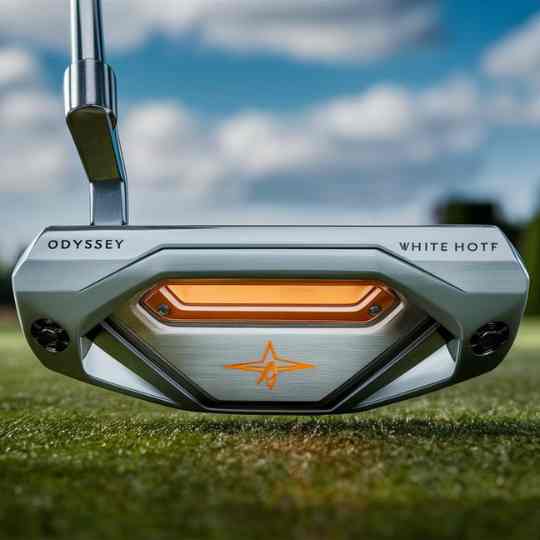
Renowned for its versatility and high-caliber performance, the Odyssey Golf White Hot OG Putter is a top choice for beginners seeking consistency and precision on the green.
With its rectangular club head design and striking red shaft, it exudes confidence and style. The face-balanced club head ensures stability at impact, ideal for players with varying putting strokes.
Its larger tipping point and forgiving nature make it suitable for amateurs looking to improve their game.
Whether executing subtle curves or sharp strokes, the Odyssey Golf White Hot OG Putter offers reliability and performance, making it a trusted companion for beginner golfers aiming to elevate their putting skills.
Pros
Cons
Odyssey DFX Golf Putter
The Odyssey DFX Putter combines advanced technology with ergonomic design to deliver stability and precision for beginners.
Constructed with a steel chassis and sik face Innovation, it offers enhanced stability and consistent ball speeds across the face. Its multi-material composition increases MOI, providing forgiveness on mishit putts. T
he comfortable grip ensures prolonged use without discomfort, perfect for practice sessions. With a fetch ball pickup function, it offers added convenience on the course. Whether seeking consistency or precision, the Odyssey DFX Putter is a reliable choice for beginners striving to improve their putting game.
Pros
Cons
How to Know When to Change Your Putter
Self-Assessment of Performance
- List of Indicators:
- Inconsistent Putting: Missing putts that you usually make.
- Distance Control Issues: Difficulty in gauging the distance accurately.
- Alignment Problems: Frequently missing putts to one side.
- Feel and Comfort: Lack of confidence or discomfort while using the putter.
- Visual Wear and Tear: Significant wear on the putter’s face or grip.
Analyze Performance Metrics
- Table of Performance Metrics:
| Metric | Current Performance | Desired Performance | Difference |
| Average Putts per Round | 32 | 30 | -2 |
| 3-Putts per Round | 5 | 2 | -3 |
| Make Percentage (5ft) | 60% | 80% | -20% |
| Make Percentage (10ft) | 30% | 50% | -20% |
Evaluate Putter Condition
- List of Putter Condition Checks:
- Grip: Check for wear, tears, or slippage.
- Face: Inspect for dings, dents, or worn spots.
- Shaft: Look for bends or rust.
- Overall Balance: Ensure it still feels balanced and performs well.
Testing Alternatives
- List of Testing Steps:
- Visit a golf store or fitting center.
- Try putters with different weights, lengths, and head shapes.
- Use a putting green to test various putters under similar conditions to your usual play.
- Get feedback from a professional or use a putting analysis system.
Make a Decision
- List of Decision-Making Factors:
- Improvement in metrics during testing.
- Increased comfort and confidence.
- Positive feedback from fitting professionals.
- Better performance in practice rounds.
Determining When to Change Your Putter

Common Mistakes to Avoid When Choosing a Putter
Ignoring Personal Preference
When it comes to choosing a putter, your personal preference is crucial. It’s easy to get swayed by what others are using or what’s popular, but the most important factor is how the putter feels in your hands. The right putter for you is one that you find comfortable and confidence-inspiring. Spend some time trying different putters to see which one feels best. Trust your instincts—if a putter feels good to you, it’s likely to improve your game.
Not Considering Stroke Type
Your stroke type plays a significant role in determining which putter will work best for you. Whether you have a straight-back-straight-through stroke or a slight arc, there’s a putter design that will complement your style. Ignoring your stroke type can lead to inconsistent performance. For example, a face-balanced putter works well for a straight stroke, while a toe-hang putter suits an arcing stroke. Understanding your stroke type can guide you to a putter that enhances your natural motion and improves your accuracy.
Overlooking Custom Fitting
Custom fitting isn’t just for drivers and irons; it’s equally important for putters. Many golfers overlook this step, but a custom-fitted putter can make a huge difference. A professional fitting session will assess your stroke, posture, and alignment to match you with a putter that fits you perfectly. Factors like length, lie angle, and grip size can all be tailored to your specifications. Investing in a custom fitting ensures that you’re not just picking a putter off the shelf, but getting one that’s made to fit you.
Getting Distracted by Branding
It’s easy to get caught up in the allure of big brands and their latest models. While brand reputation can indicate quality, it shouldn’t be the only factor you consider. The performance and suitability of the putter for your game are far more important. Try not to be swayed by marketing hype or the brand’s prestige. Focus on how the putter performs in your hands, how it feels during your stroke, and whether it helps you make more putts. Sometimes, lesser-known brands offer putters that could be a perfect fit for you, without the hefty price tag.
By avoiding these common mistakes, you can choose a putter that truly enhances your game. Remember, the best putter is the one that feels right for you, matches your stroke type, fits your body and playing style, and performs well on the green.
Putter Selection: Common Mistakes and How to Avoid Them
Overlooking Putter Length: A putter that’s too long or too short can mess with your stance and swing. Make sure it feels comfortable and matches your height.
Neglecting Putter Weight: The weight of the putter head can affect your control. Too heavy or too light, and it can throw off your game.
Skipping a Putter Fitting: Just like drivers, putters can be fitted to your specs. A professional fitting can make a huge difference in your performance.
Choosing Style Over Substance: A cool-looking putter isn’t always the best for your game. Focus on how it performs, not just how it looks.
Ignoring Grip Type: The grip affects how you hold the putter and your overall comfort. Try different grips to find what suits you best.
Forgetting About Feel: The feel of the putter when it strikes the ball is crucial. Make sure you like the feedback it provides.
Not Considering Putter Balance: Different putters are balanced differently – some are toe-balanced, others are face-balanced. Match this to your stroke type.
Rushing the Decision: Take your time to test different putters. Rushing can lead to choosing one that doesn’t suit you.
Ignoring Club Face Design: The face design can affect how the ball rolls. Look for a face that complements your stroke and gives a consistent roll.
Not Testing on Different Greens: Try the putter on various greens if possible. What works on one type might not work on another.
Underestimating Alignment Aids: Many putters come with alignment aids. They can be incredibly helpful for improving your aim.
Relying Solely on Brand Reputation: Just because a putter is from a well-known brand doesn’t mean it’s the best for you. Test it out yourself.
Skipping Online Reviews and Research: Other golfers’ experiences can give you insights into the putter’s performance. Don’t skip the research.
Tips for Testing and Selecting the Right Putter
Best putters are the unsung heroes of the golf course, wielding precision and finesse. With the best putters in hand, sinking those crucial shots becomes a seamless endeavor.
Visiting a Professional
One of the best steps you can take in finding the right putter is to seek advice from a golf professional or a club fitter. These experts have the experience and tools to assess your putting stroke and recommend putters that match your style. By visiting a professional, you can get a personalized fitting that considers your height, grip, and stance. This tailored approach often leads to better performance on the green and a more enjoyable game overall.
Testing Multiple Options
Don’t settle for the first putter you try. It’s crucial to test multiple options to find the one that feels best in your hands and suits your putting stroke. Head to a golf shop or a fitting center where you can try out a variety of putters. Pay attention to the weight, length, and grip of each one. Trying different models will give you a better sense of what works for you and help you make an informed decision.
Taking Note of Performance
As you test different putters, make sure to observe how each one performs. Notice how the ball rolls off the face, the balance and feel of the putter, and your overall accuracy. Spend time on the practice green hitting putts from various distances. A good putter should help you maintain a consistent stroke and improve your confidence. Keep track of which putters give you the best results and feel the most comfortable.
Considering Course Conditions
Finally, it’s important to consider the course conditions where you usually play. Greens can vary in speed, grain, and firmness, and these factors can affect how a putter performs. If possible, test putters under different conditions to see how they handle. Some putters may excel on fast greens but not perform as well on slower ones. By testing in a variety of conditions, you can choose a putter that will be versatile and reliable no matter where you play.
Finding the right putter is a process that takes time and experimentation, but it’s worth the effort. By visiting a professional, trying multiple options, noting performance, and considering course conditions, you’ll be well on your way to selecting the perfect putter for your game.
FAQs
What makes a putter the best choice for me?
The best putter for you depends on your putting stroke, preferences, and feel. It’s essential to try different putters to find the one that aligns with your stroke style and feels comfortable in your hands.
Should I choose a blade or mallet putter?
Blade putters offer a traditional look and are preferred by golfers who prefer a classic feel and precision. Mallet putters, on the other hand, often provide more forgiveness and stability due to their larger head design, which can help with alignment and consistency.
What is the importance of putter alignment aids?
Putters with alignment aids, such as lines or dots on the crown or a contrasting color scheme, can assist in aiming the putter face accurately. Choosing a putter with alignment features that suit your visual preferences and help you align your putts consistently can improve your putting performance.
Does putter length matter?
Putter length is crucial as it directly affects your setup and posture during putting. The standard length for putters is around 34-35 inches, but custom options are available. Ensure that the putter length allows you to maintain a comfortable and consistent setup for better control and accuracy.
What role does putter weight play in performance?
Putter weight influences the feel and stability of your stroke. Lighter putters may offer more control and finesse, while heavier putters can provide stability and help smooth out your stroke. Experimenting with different weights can help you find the optimal balance between feel and performance for your putting style.
Conclusion
Selecting the best putter for your game is a crucial decision that can significantly impact your performance on the greens. With numerous options available on the market, it’s essential to consider factors such as feel, alignment aids, and stroke type to find the putter that suits your individual preferences and playing style. Remember, what works for someone else may not necessarily work for you.
Therefore, taking the time to test different putters and seeking advice from professionals can help you make an informed decision. Ultimately, the best putter is the one that gives you confidence and consistency on the green, helping you sink more putts and lower your scores. So, trust your instincts and choose wisely to improve your putting game and enjoy greater success on the golf course.

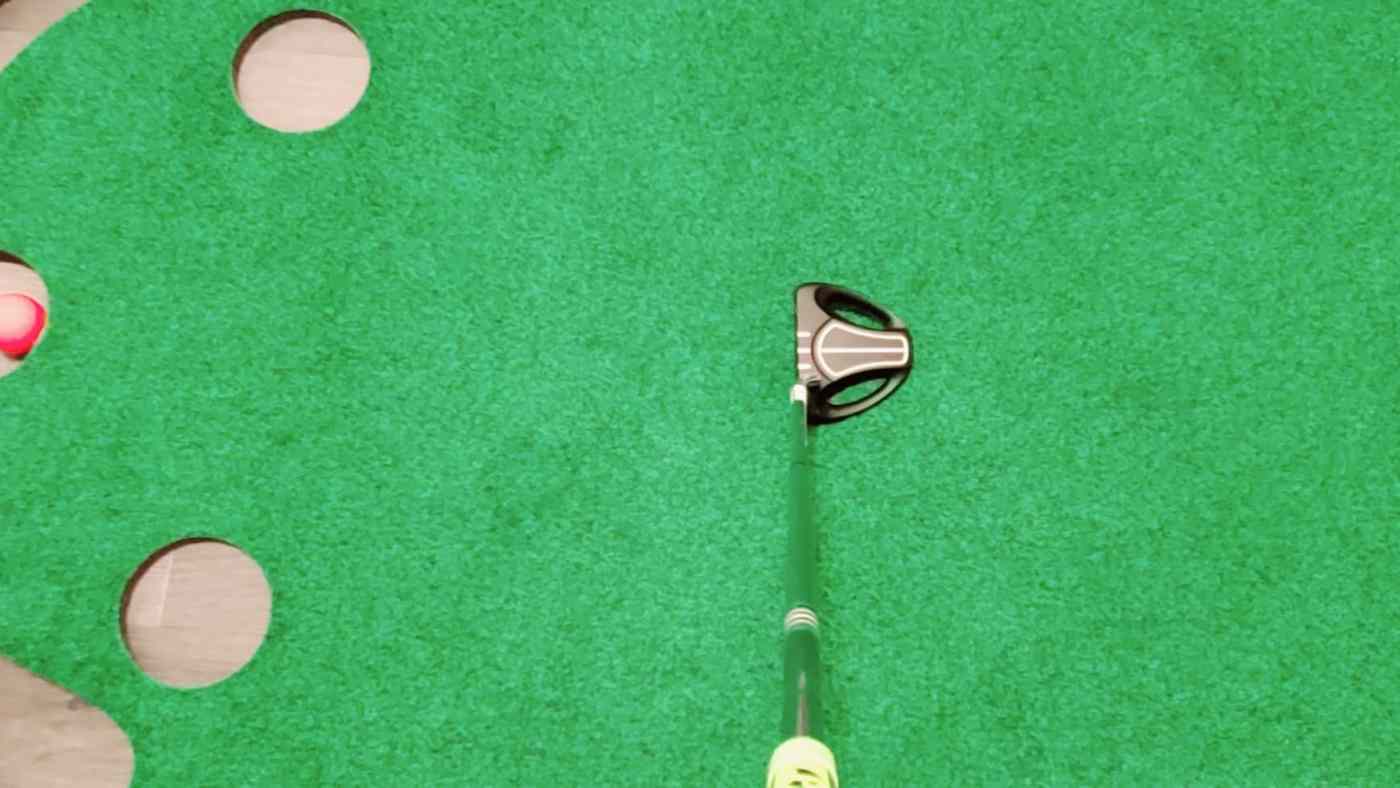








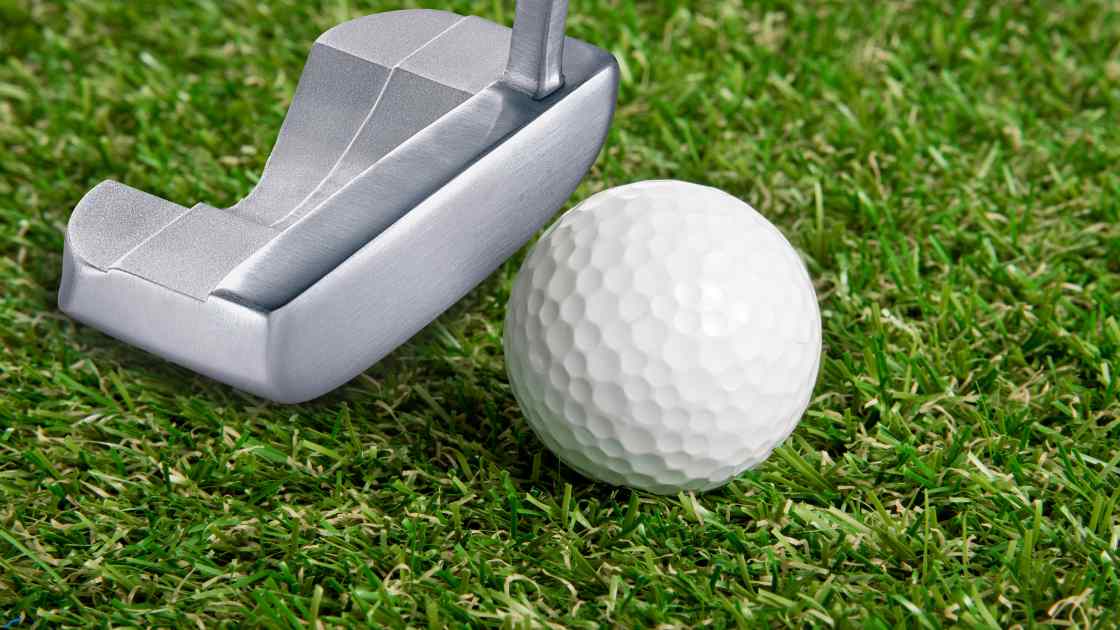


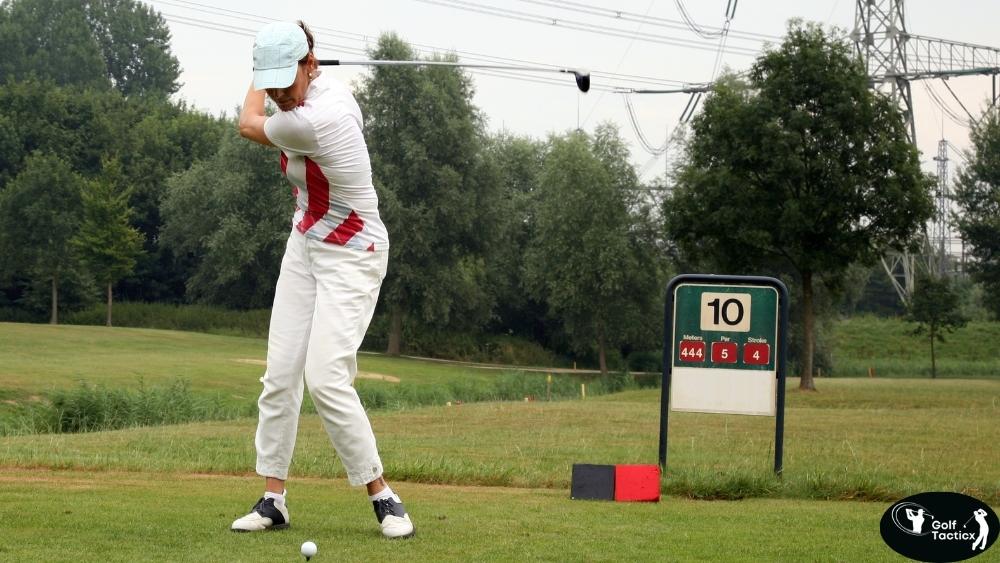


Leave a Reply